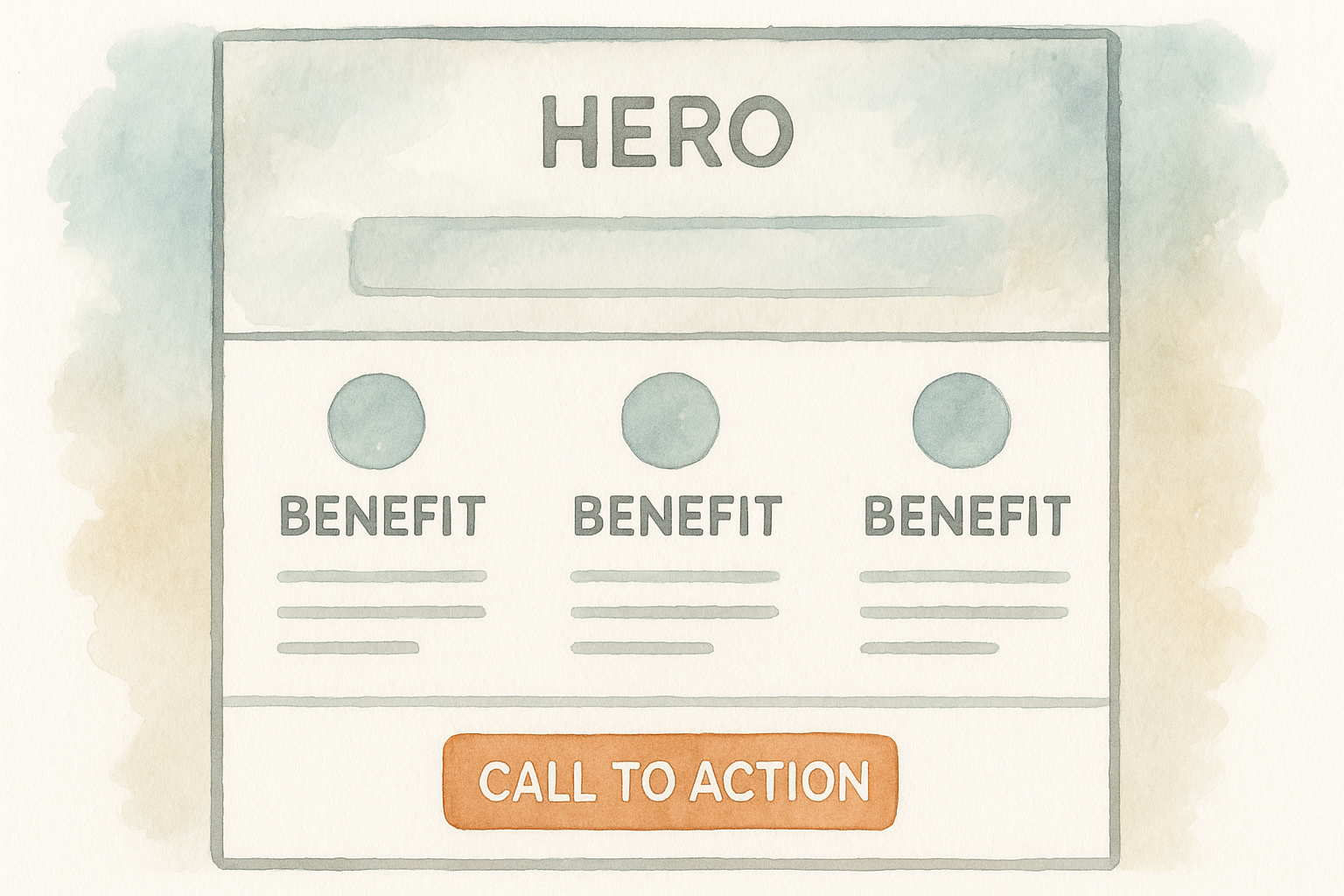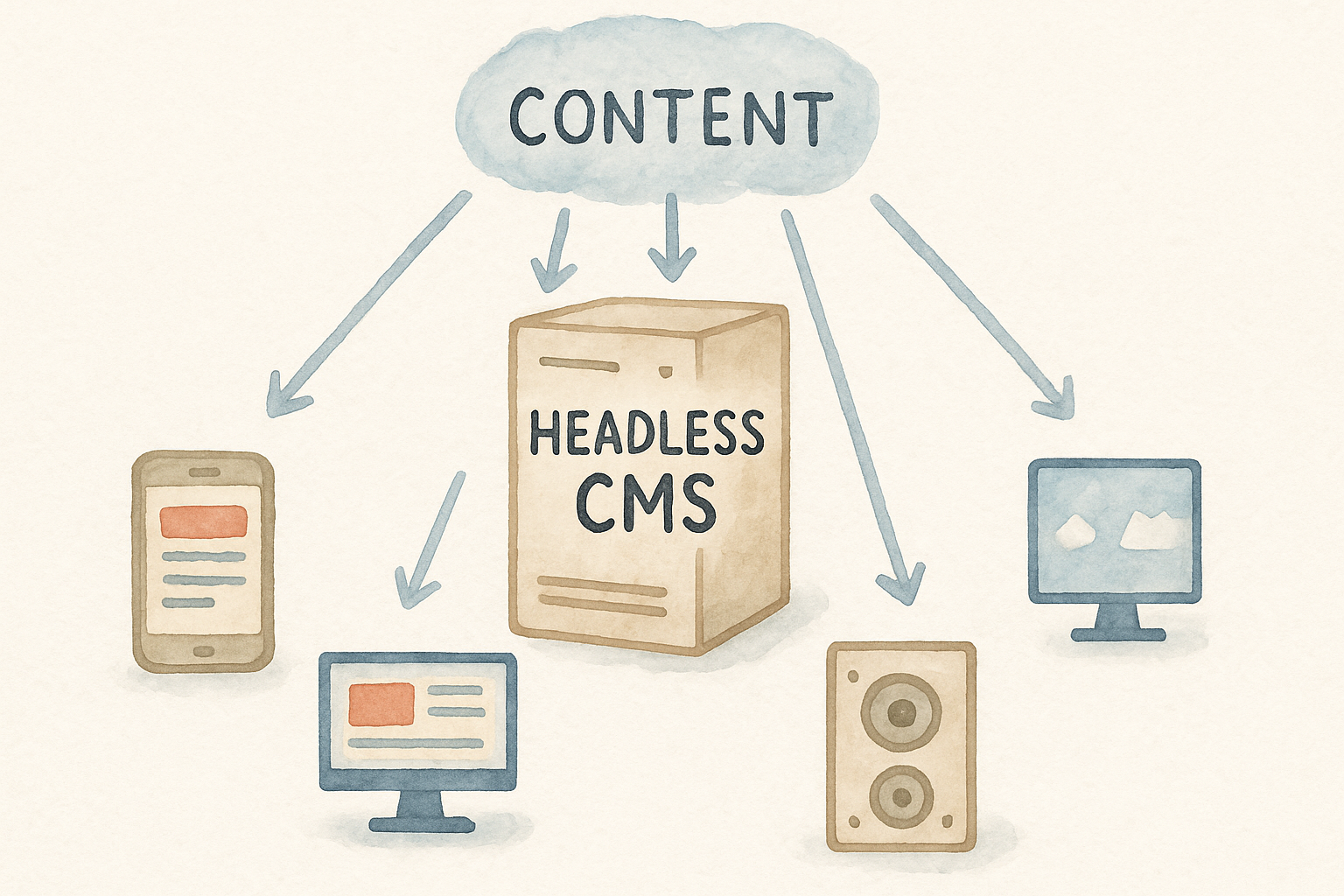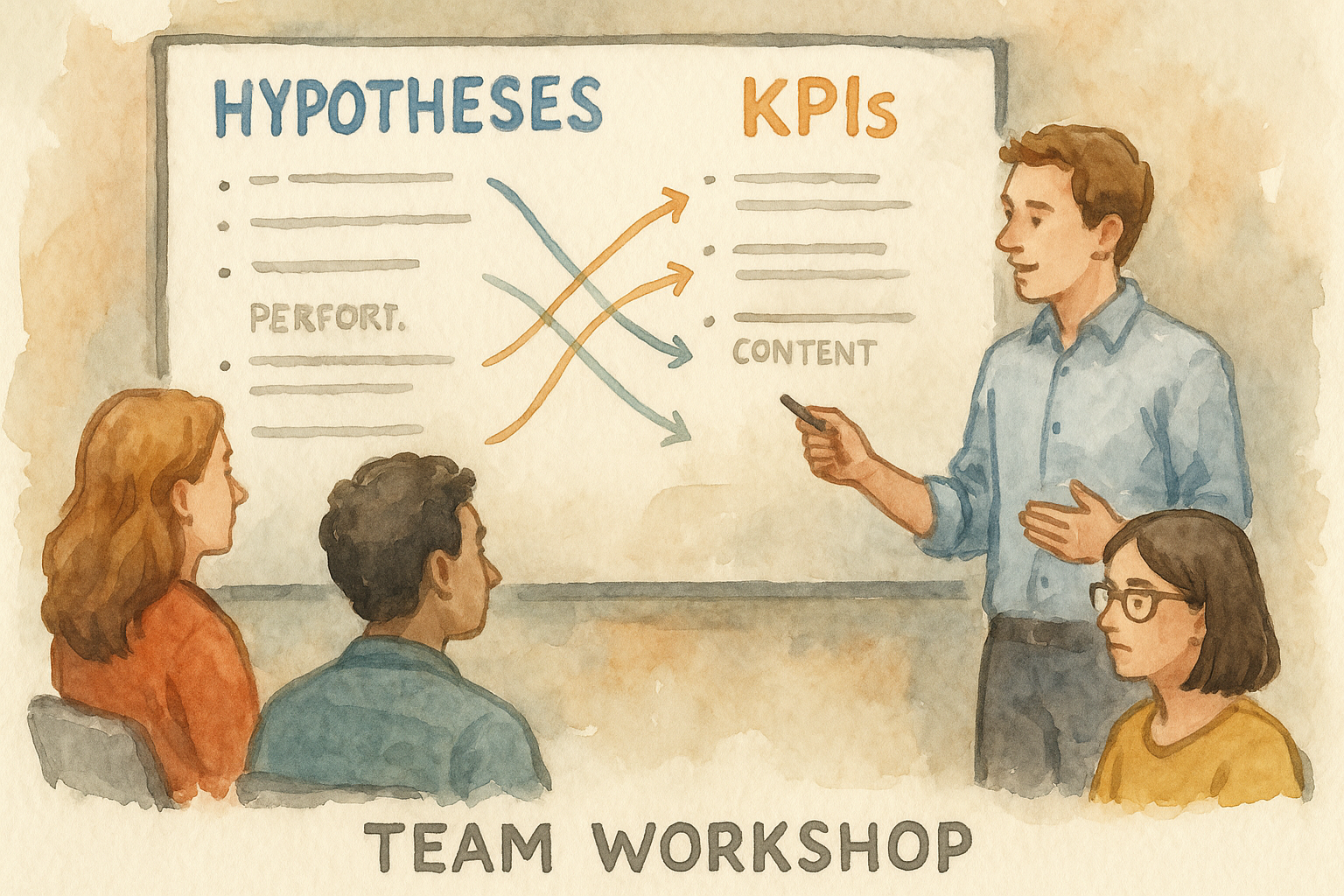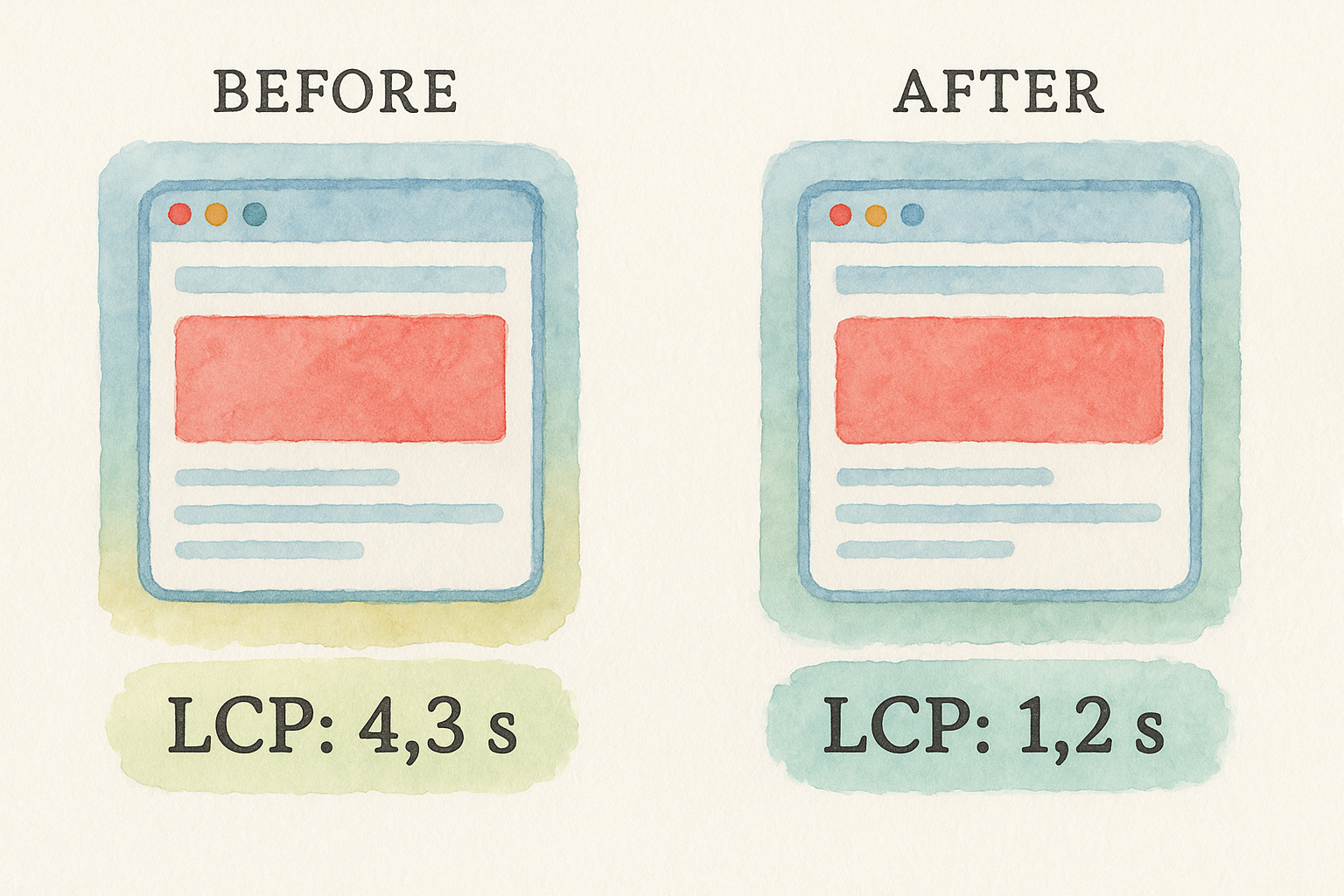Performance content is increasingly the metric-driven core of modern growth teams: it turns pages into measurable business outcomes.
But what is performance content, exactly?
This guide is a complete cheatsheet and playbook you can apply — step-by-step.
Some are short landing pages designed to convert visitors now.
Some are long-form pillars that educate and nudge prospects down-funnel.
Some are microcopy experiments that cut friction in forms and flows.
Some are technical fixes that recover lost conversions in milliseconds.
Some are full funnel programs combining SEO, paid, email and product messaging.
Let's dive right in.
What is performance content?
Performance content is content deliberately designed and optimized to achieve measurable business outcomes — revenue, sign-ups, activation, retention, or other high-value actions. From the start, it is outcome-first: every page, paragraph, and pixel exists to move a KPI.
Think of it this way: most content tells a story. Performance content tells a story and measures the purchase intent of the reader while actively nudging them to the next step.
Core principles include hypothesis-driven development, intent alignment, technical excellence, and repeatable processes (briefs, templates, measurement plans). We'll unpack each of these across the guide.
Why the definition matters
Definitions shape decisions. If your team thinks "content" is just blog posts, you'll miss the biggest opportunity: turning content into a predictable growth lever that scales acquisition and revenue.
Why performance content matters
Performance content bridges traffic and business. It ensures organic, paid, and owned channels produce tangible value rather than vanity metrics.
When you design content for outcomes, you can optimize acquisition cost, improve lifetime value, and reduce churn by setting user expectations correctly.
Example: improving page quality and speed often increases conversions. Page speed improves user trust — and trust converts. Case studies from enterprise and retail show even sub-second changes in load time affect conversion rates markedly; see research aggregated on page speed impacts from Conductor.
Types and formats of performance content
Performance content can exist at every funnel stage and in many formats. The format you choose must match user intent and the metric you want to move.
Landing pages & product pages
These are the highest-leverage assets. A well-built landing page converts visitors directly — hero value proposition, evidence, simplified pricing, and a single primary CTA. A/B testing hero headlines, CTAs, and social proof in this format yields quick wins.

Long-form pillars & comparison pages
Long-form content educates, ranks in search, and can funnel users to conversion points embedded across the article. Use clear CTAs, product comparisons, pricing callouts, and inline lead magnets to convert organic visitors.
Paid creative and message-match
Ads must align with landing page messaging. Performance content includes the short-form ad copy and the landing experience — both must be tested as a pair to maximize ROAS.
Email & lifecycle messaging
Email content is one of the most efficient conversion channels. Create flows with conversion-optimized subject lines, preview text, and body content that lead recipients to a single, measurable next step.
Microcopy & UX content
Microcopy (button text, error messages, field hints) reduces friction and often yields outsized conversion lifts for small changes.
Interactive & personalized content
Personalization increases relevance but introduces privacy considerations. Use consent-first personalization and test lifts with control cohorts. For consumer preferences studies on personalization, see broader research like the consumer personalization literature available via research summaries.
Core metrics and KPIs
Measure what matters. Your metrics fall into acquisition, engagement, conversion, retention, and technical performance categories. Below is a practical mapping with definitions and examples.
Acquisition metrics
- CTR: click-through rate from SERPs or ads — does your title/meta or ad creative attract the right click?
- CPC / Cost per acquisition (CPA): critical for paid channels — ties directly to profitability.
- Revenue per visitor (RPV): total revenue divided by visits — useful for gauging the value of traffic; explained well by Optimizely: Revenue per visitor.
Engagement metrics
Engagement signals like time on page, scroll depth, and pages per session indicate whether content meets intent. However, they are intermediates — they should correlate with conversions.
Use product analytics and content analytics together; for example, HubSpot's content performance tools show how individual pages drive new contacts and customers: HubSpot content analytics.
Conversion metrics
Conversion rate, average order value (AOV), revenue per visitor, and lead quality are key. For SaaS: activation rate, trial-to-paid conversion, and time-to-value are crucial.
Retention metrics
Retention cohorts, churn, repeat purchase rate, and LTV tell whether content helped deliver long-term value.
Technical performance metrics
Core Web Vitals (LCP, CLS, FID/Total Blocking Time), TTFB, and page weight directly influence user experience and therefore conversion rate. Conductor compiles multiple case studies showing how speed gains translate into conversion lifts and lower abandonment: Core Web Vitals & page speed resources.
Research & planning
Good performance content begins with research. Use qualitative inputs (interviews, support logs) and quantitative data (analytics, cohort analysis). Map keywords to intent and funnel stage, not just volume.
Audience & persona research
Create lean, testable personas with intent signals attached. For each persona, list: primary goal, common obstacles, trust signals that reduce friction, and the target CTA. Example: "Marketing Manager, seeks 3rd-party validation before recommending tools to stakeholders; values data and short demos."
Keyword & intent mapping
Prioritize keywords by commercial intent (e.g., "best [product]" or "[product] vs [competitor]") for conversion pages. Long-tail queries often convert better and are faster to rank for.
Competitive & gap analysis
Audit competing pages: how do they structure hero sections, evidence, and CTAs? Build a gap spreadsheet: where can you provide superior evidence, clearer UX, or faster pages?
Hypothesis-driven planning
Every content piece should be backed by a hypothesis: "If we rewrite the hero headline to focus on X benefit, trial signups will increase by Y% among paid traffic." Translate hypotheses into measurable OKRs.
Creating high-performing content: process & best practices
Production should be repeatable. Use a briefing template and checklists that require KPI, audience, CTAs, tracking needs, and success criteria. Below is a production playbook you can copy.
Briefing template — required inputs
- Objective / KPI (e.g., increase trial signups by 20% in 90 days)
- Audience & funnel stage
- Primary & secondary CTAs
- Target keywords and intent
- Success metrics & acceptable MDE
- Competitive references & banned elements
- Technical constraints & tracking requirements
Message architecture & value proposition
Start with the single most important idea: the one sentence that must be understood within three seconds. Support it with three proof pillars: benefit, evidence, differentiation. Repeat the proposition in different formats (hero, bullets, testimonial, CTA).
Copywriting tactics for conversion
Use benefit-first headlines, active voice, social proof, and risk-reversal tactics. Short sentences. Scannable lists. Strong CTA verbs. Test variants like "Start free trial" vs "Get started" — small differences often move the needle.
UX & information architecture
Design to guide eyes and actions. Hero contains primary CTA. Remove distractions (unnecessary nav on landing pages). For comparison pages, use sortable tables and concise CTAs embedded near the most persuasive content.
Design assets
Optimize images (responsive sizes, WebP), use illustrations to reduce cognitive load, and trim videos to key moments. Lazy-load non-essential media.

Technical optimization
Technical performance is part of the content experience. Speed, accessibility, and structured data affect discoverability and conversion. Below are detailed steps by metric.
Page speed & Core Web Vitals
Core Web Vitals are LCP (Largest Contentful Paint), CLS (Cumulative Layout Shift), and FID or interaction proxies (First Input Delay / Total Blocking Time). These metrics measure how quickly content appears, how stable the layout is, and how responsive the page feels.
Why it matters: multiple case studies compiled by industry sources show faster pages convert better. For example, companies that optimized LCP and other vitals saw measurable uplift in conversions and reductions in abandonment; Conductor's page speed resources summarize many of those examples: page speed case studies.
Practical checklist to improve Core Web Vitals
- Use a CDN and good hosting to reduce TTFB.
- Serve images in modern formats (WebP/AVIF) and implement responsive srcset.
- Preload critical assets (fonts, hero image) and inline critical CSS for above-the-fold content.
- Defer non-critical JavaScript and split heavy bundles via code-splitting.
- Add width/height attributes to images and reserve space for ads/iframes to avoid CLS.
- Measure both lab and field data (PageSpeed Insights for lab + CrUX via Search Console for field).
Embed: Page speed quick wins (video)
For practical hosting and caching tactics, watch this quick guide on optimizing eCommerce site performance:
Structured data & SEO fundamentals
Implement schema for Product, FAQ, Review, and Breadcrumbs to improve SERP presentation (rich results). Optimize title tags and meta descriptions for CTR. Use canonical tags to prevent duplication issues.
Responsive & accessible content
Mobile-first design is essential. Ensure logical heading structure, large touch targets, and screen-reader friendly markup. Accessibility reduces friction — and a better experience raises conversions.
Personalization & privacy
Personalization boosts relevance but watch consent. Use server-side personalization where possible to maintain performance and avoid layout shifts. Research into consumer preferences warns that overly aggressive personalization can harm trust — ensure clear opt-ins and transparent data use policies (research insights).
Testing & experimentation
Performance content is only as good as your experiments. Build a testing culture and a reliable stack to validate hypotheses and scale winners.
Setting up experiments
Every test requires a hypothesis, primary & secondary metrics, MDE (minimum detectable effect), sample size, test duration, QA, and rollback criteria. Validate tracking before launching.
A/B testing best practices
- Test one major change at a time for causal clarity (headline, CTA, price presentation).
- Use significance calculators but prioritize business impact (revenue per visitor, not just p-values).
- Run tests long enough to avoid seasonal or weekday bias.
Multivariate & personalization tests
Reserve multivariate tests for high-traffic pages. For personalization, run cohort-targeted experiments with holdouts to verify real uplift and durability across segments.
Interpreting results
Watch for false positives: peeking, novelty effects, bot traffic, and tracking errors. Use holdouts and validate downstream metrics like retention to ensure short-term wins don't reduce long-term value.
Distribution & channel strategy
Build a channel plan that amplifies high-performing pages. Organic search is persistent and scalable when paired with conversion-optimized landing pages. Paid channels accelerate learning and scale winners.
Organic search
Optimize content for target keywords and intent. Earn backlinks by creating linkable assets (data studies, unique tools) and perform outreach to relevant partners.
Paid amplification
Use paid channels to validate message/offer quickly. Test ad-to-landing page message match to maintain relevancy and lower CAC.
Email & retargeting
Use email nurture to convert high-intent leads. Retargeting audiences based on page behavior can recover lost conversions (cart abandoners, engaged readers, feature explorers).
Social & syndication
Social drives top-of-funnel visibility. Use snappy content snippets and carousel ads to pull users to conversion-optimized pages. Syndication deals for high-value assets can amplify reach when aligned with audience intent.
Measurement, reporting & attribution
Map content events to revenue. Use a consistent naming convention and a tracking plan that ties button clicks to pipeline outcomes. When possible, map content interactions to closed-won deals using CRM integrations.
Instrumentation & events
Define events: hero CTA click, demo booking, trial activation, subscription purchase. Verify events with debug tools and QA across browsers and devices.
Attribution models
Multi-touch or data-driven attribution is preferable for longer sales cycles. Single-touch models miscredit the content that truly influenced the buyer.
Dashboards & cadence
Create dashboards that show leading indicators (CTR, engagement) and lagging indicators (revenue, LTV). Share weekly experiment digests and a monthly performance report with stakeholders.
Technology stack recommendations
Choose tools that support speed, experiments, and data integrity. Below is a pragmatic stack for high-performance content teams.
CMS & content operations
Use a CMS that supports structured content and fast rendering. Headless CMS architectures allow separation of content and presentation for easier personalization and faster experiments.

Analytics & experimentation
Analytics: GA4 or server-side analytics. Experimentation: Optimizely, VWO, or in-house frameworks. CDP: Segment or RudderStack to unify events and identity.
Delivery & infrastructure
Use a CDN (Cloudflare, Fastly, CloudFront) and modern hosting for global performance. For personalization, prefer server-side or edge-side logic to preserve page stability.
Templates, checklists & playbooks
Templates make quality repeatable. Below are condensed templates you can adapt immediately.
Performance content brief (copy)
Objective/KPI — Persona — Funnel Stage — Target Keywords — Primary CTA — Success Metric — Creative examples — Technical constraints — Tracking events.
Experiment planning template
Hypothesis — Primary & secondary metrics — Audience targeting — Variations — Sample size — Duration — QA — Rollback criteria.
Launch checklist
- Meta tags optimized
- Structured data added
- Mobile UX QA
- Image optimization & lazy loading
- Tracking pixels & events verified
- A/B test setup validated
- Cross-browser/device QA
Common pitfalls & how to avoid them
Teams fall into common traps when building performance content. Here are the most damaging and how to avoid them.
Chasing vanity metrics
Traffic without conversion is decoration. Tie experiments to revenue or a meaningful micro-conversion and prioritize revenue-per-visitor (RPV) and conversion rate over raw sessions.
Over-personalization & privacy
Personalization without consent harms trust. Use transparent opt-ins and privacy-respecting techniques. Keep personalization meaningful and not creepy.
Poor QA & inconsistent messaging
Broken CTAs, mismatched offers, or incorrect tracking kills experiments. Use pre-launch checklists and a staging QA process to avoid release errors.
Example case studies & quick wins
Concrete examples illustrate how small changes produce outsized impact.
Small changes, big impact
Example: Changing a CTA from "Submit" to "Get my quote" can increase perceived clarity and lift conversions. Removing non-essential form fields typically increases form completion rates. Adding trust badges near CTAs reduces hesitation in purchase flows.
End-to-end SaaS example
Scenario: A SaaS firm targets a high-intent keyword. Hypothesis: A hero rewrite + social proof + simplified pricing will increase free trials by 25% in 90 days. Execution: Create new landing page, set up experiment, QA tracking. Result: Winning variant produced 27% uplift; retention stable; paid campaigns scaled.
Page speed case reference
Summary: Numerous companies documented conversion uplifts by improving LCP and other vitals. Industry roundups on page speed demonstrate the direct link between faster pages and better conversion/commercial outcomes: Conductor's page speed resources.
FAQ
When should I prioritize performance content?
Prioritize when you need predictable outcomes: product launches, high CAC periods, or when organic traffic fails to convert. Performance content is essential when you must scale revenue predictably.
How often should I test?
Continuously where traffic supports it. For low-traffic pages, combine A/B testing with qualitative research and iterative improvements. Re-run tests after major seasonality or product changes.
How do I balance brand and performance goals?
Split efforts: brand-building experiments for upper-funnel, direct-response tactics for lower-funnel. Keep brand voice consistent but allow performance teams flexibility to use conversion-focused language in mid/bottom funnel assets.
30/60/90 day action plan
Follow this practical roadmap to launch a performance content practice.
First 30 days
- Audit top-converting pages and map metrics.
- Implement a standardized performance content brief.
- Fix the top 3 technical performance issues (TTFB, LCP, CLS).
60 days
- Launch A/B tests on key landing pages.
- Set up KPI dashboards (leading & lagging indicators).
- Align paid ad messaging to landing pages and begin scaling winners cautiously.
90 days
- Roll out personalization for highest-value segments with holdouts.
- Document playbooks and scale winning experiments across product lines.
- Run a post-mortem and hand off documentation to ops.
Conclusion & resources
Performance content transforms content from a cost center to a predictable growth engine. Start small: pick one high-impact page, define the KPI, create a hypothesis, and measure everything.
For help choosing partners or vendors who can accelerate execution, learn how to choose the right SEO agency for startups—this resource walks through procurement, scope, and ROI considerations.
Quick checklist (copyable)
- Start with an outcome and a hypothesis.
- Use persona and intent-driven research.
- Write clear, benefit-first copy and optimize microcopy.
- Ensure pages load quickly and are mobile-first.
- Instrument everything with consistent events and UTMs.
- Run controlled experiments and validate downstream metrics.
- Scale winners and codify playbooks.
Use the resources linked in this guide to prioritize improvements. For content analytics and per-page audience conversion tracking, see HubSpot's content analytics documentation: HubSpot content performance. For revenue-per-visitor calculations and tradeoffs, reference industry definitions: Optimizely on RPV.


Start with one page this week. Define a clear KPI, instrument tracking, and test a single hypothesis. Measure revenue impact, not just clicks. If you follow the discipline outlined here — research, craft, technical execution, measurement, and experimentation — performance content becomes your most reliable lever for growth.